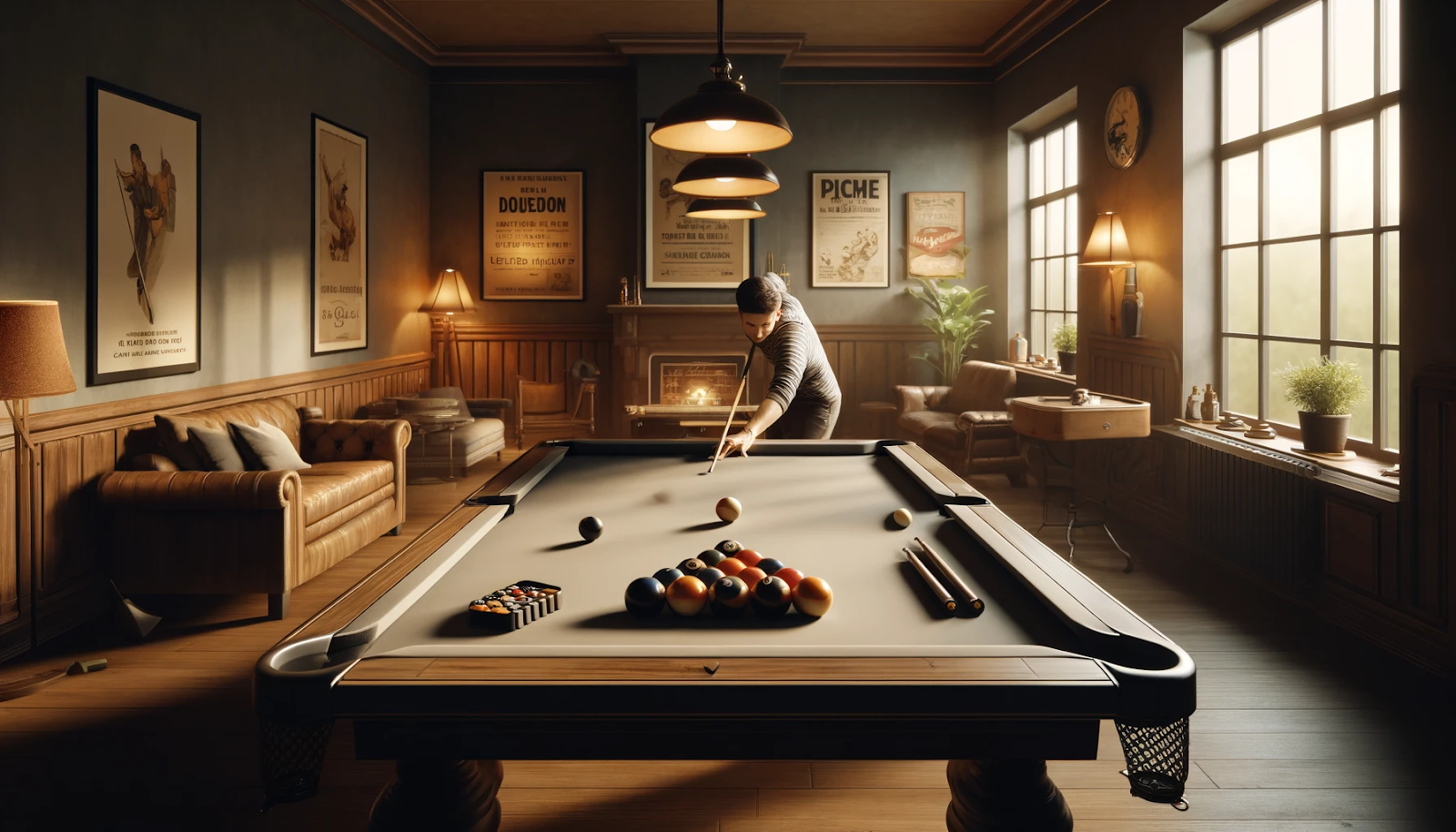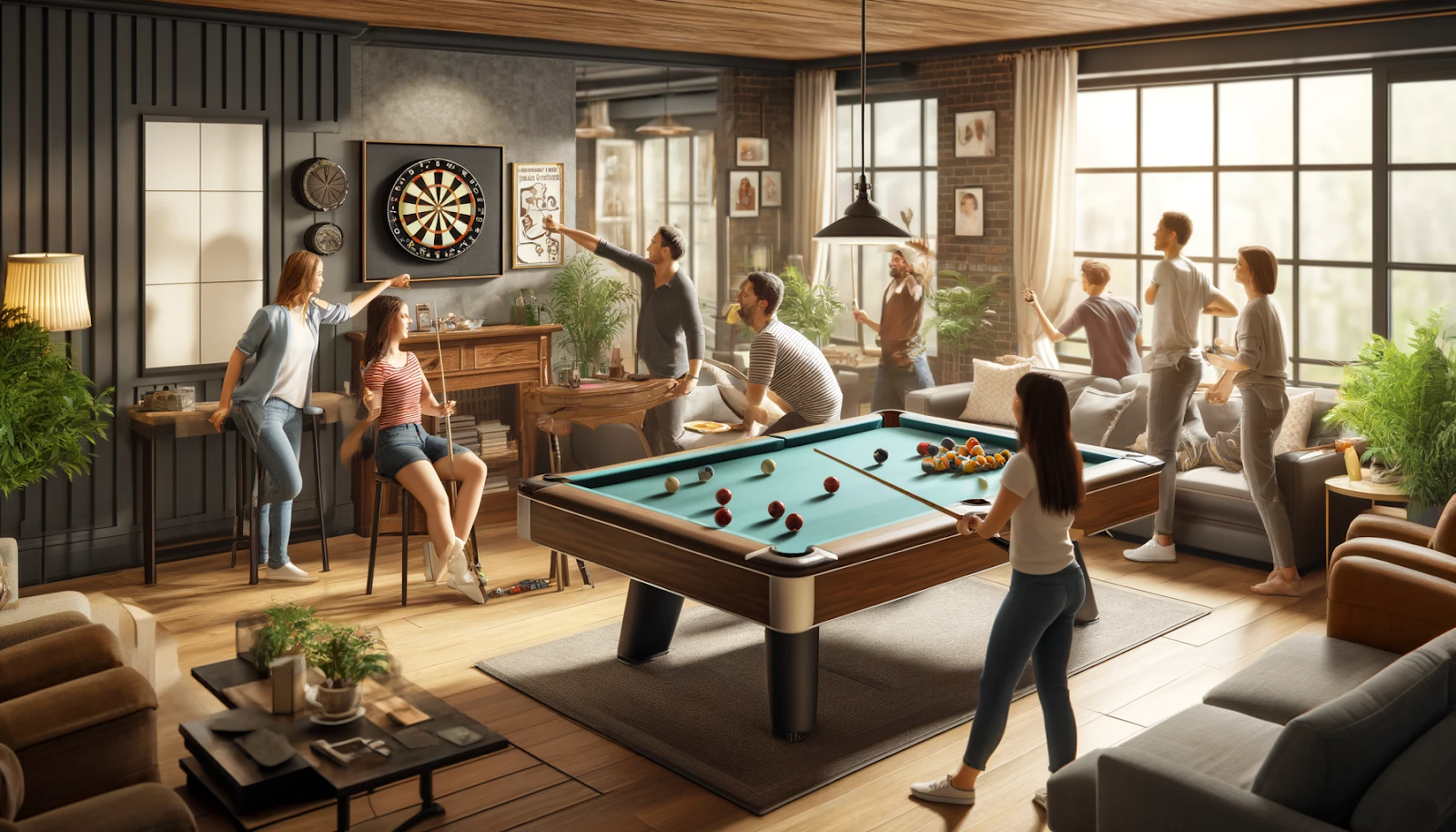When it comes to home entertainment, few activities can match the excitement and camaraderie of playing billiards or throwing darts with friends and family. These classic pastimes have stood the test of time, offering a perfect blend of skill, strategy, and social interaction. In this article, we’ll dive into the essentials of setting up a billiards or darts area in your home, exploring the necessary equipment, techniques, and benefits of these engaging activities.
Billiards: A Game of Precision and Finesse

Billiards, also known as pool, is a timeless game that has captivated players for centuries. The objective is simple: using a cue stick, players must strike the cue ball to pocket the other balls in a specific order. However, mastering the game requires a keen eye, a steady hand, and strategic thinking.
To set up a billiards area in your home, you’ll need a pool table, cue sticks, balls, and a few accessories. Pool tables come in various sizes, with the most common being 7, 8, or 9 feet in length. When choosing a table, consider the available space in your room and the level of play you aspire to achieve. Opt for a high-quality slate table for the best playing experience, as it provides a flat and consistent surface.
Cue sticks, the tools used to strike the balls, come in different weights and materials. As a beginner, start with a medium-weight cue that feels comfortable in your hand. As you progress, you may want to invest in a higher-end cue that suits your playing style.
To elevate your billiards skills, focus on your stance, grip, and aim. Keep your body stable, with your dominant foot slightly forward, and maintain a loose but controlled grip on the cue. Practice aiming by aligning your cue with the imaginary line between the cue ball and your target.
Darts: Precision Meets Fun

Darts is another classic game that has gained popularity in both pubs and homes worldwide. The objective is to throw small missiles, called darts, at a circular target (dartboard) hung on a wall. Players take turns aiming for specific areas on the board, each assigned different point values.
To create a darts setup in your home, you’ll need a dartboard, darts, and a suitable wall space. Dartboards come in various materials, such as bristle (sisal) or electronic versions. Bristle boards are the traditional choice and are used in professional competitions. They are made of tightly packed sisal fibers that self-heal after each dart strike.
When hanging your dartboard, follow the official height and distance regulations. The center of the board should be 5 feet 8 inches (1.73 meters) from the floor, and the throwing line (oche) should be 7 feet 9.25 inches (2.37 meters) from the face of the board.
To improve your darts skills, focus on your stance, grip, and release. Stand sideways to the board, with your dominant foot slightly forward, and keep your body stable. Hold the dart between your thumb and first two fingers, and aim by aligning your dominant eye with the target. Practice a consistent release by letting the dart roll off your fingers smoothly.
The Benefits of Home Entertainment Games

Beyond the enjoyment they provide, billiards and darts offer numerous benefits for players of all ages. These games help develop hand-eye coordination, spatial awareness, and fine motor skills. They also encourage strategic thinking, as players must plan their shots and anticipate their opponent’s moves.
Moreover, playing billiards or darts fosters social interaction and friendly competition. Gathering around a pool table or dartboard creates an atmosphere conducive to conversation, laughter, and bonding with friends and family.
Conclusion
Bringing the excitement of billiards and darts into your home is a fantastic way to create a vibrant and engaging entertainment space. By investing in quality equipment, setting up your playing area correctly, and practicing the fundamental techniques, you’ll be well on your way to mastering these timeless games.
Remember, the key to enjoyment is not just about winning but also about the shared experiences and memories created along the way. So gather your friends, family, or even friendly rivals, and let the games begin!
Whether you’re a seasoned player or a curious beginner, the world of billiards and darts offers endless opportunities for fun, skill development, and camaraderie. Embrace these classic pastimes and discover the joy of home entertainment at its finest.
FAQs About Billiards to Darts
How do I choose the right size pool table?
Pool tables typically come in 7, 8, or 9-foot lengths. Consider the available space in your room and the level of play you aspire to achieve. A larger table (8 or 9 feet) is recommended for more serious players, while a 7-foot table is suitable for recreational play in smaller spaces.
What is the proper technique for playing billiards?
Proper technique involves maintaining a stable stance with your dominant foot slightly forward, keeping a loose but controlled grip on the cue, and aligning your cue with the imaginary line between the cue ball and your target. Practice your aim and follow through for more consistent shots.
What do I need to set up a darts area at home?
For a darts setup, you'll need a dartboard (bristle or electronic), a set of darts, and a suitable wall space. Bristle boards made of tightly packed sisal fibers are the traditional choice used in professional competitions.
How do I properly hang a dartboard?
The center of the dartboard should be hung at a height of 5 feet 8 inches (1.73 meters) from the floor. The throwing line (oche) should be 7 feet 9.25 inches (2.37 meters) away from the face of the board.
What are the benefits of playing billiards and darts at home?
Beyond entertainment, these games help develop hand-eye coordination, spatial awareness, fine motor skills, and strategic thinking. They also foster social interaction, friendly competition, and bonding with friends and family in a relaxed setting.
How do I improve my darts skills?
To improve your darts skills, focus on your stance (standing sideways to the board with your dominant foot slightly forward), grip (holding the dart between your thumb and first two fingers), and release (letting the dart roll off your fingers smoothly). Practice aiming by aligning your dominant eye with the target.